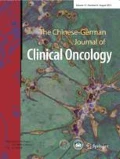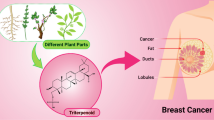Abstract
Objective
Angiogenesis plays a major role in the pathogenesis of many disorders. Vascular endothelial growth factor (VEGF) has been shown to be the key regulator of normal and pathological angiogenesis. Many studies showed that decreased expression of VEGF has been inhibited growth and migration of cancer cells. The aim of this study was to explore the effects of Betulinic acid on the VEGF expression and the growth of colorectal cell SW480 xenografts in nude mice.
Methods
The xenografts derived from colorectal cell SW480 were established in BALB/C nude mice. Inoculated mice were randomly divided into negative control (corn oil), low dose betulinic acid group (20 mg/kg/d) and high dose group (40 mg/kg/d). After 22 days, the animals were sacrificed; tumor volume and weights were measured. The mRNA level of VEGF was analyzed by quantitative real-time polymerase chain reaction. The expression of VEGF protein was detected by immunohistochemistry.
Results
The tumor weight was significantly lower in low and high dose groups than in corn oil group (1.12 ± 0.04, 0.43 ± 0.02 vs 2.08 ± 0.07; P < 0.05). The mRNA levels of VEGF was also significantly lower in betulinic acid treated groups (0.72 ± 0.02, 0.38 ± 0.01; P < 0.05) than in control group (1.08 ± 0.04). H&E staining showed tumor tissue necrosis was observed in treatment groups. The positive expression of VEGF was lower in low and high dose groups than in corn oil group. Gray scale increased in low dose group and high dose group (121.1 ± 2.8, 156.2 ± 3.3, P < 0.05).
Conclusion
Betulinic acid had significant inhibitory effect on VEGF expression and tumors growth of human colorectal cancer xenografts in vivo, and down-regulation of VEGF expression may account for one of the molecular mechanisms of the anticancer effects of betulinic acid.
Similar content being viewed by others
References
Ni JT, Yi YF, Shi HP. Expressions of Maspin, p53 and Skp2 in colorectal tumors and their clinicopathological significance. Chin J cancer Res (Chinese), 2009, 21: 147–153.
Zhang L, Yu D, Hu M, et al. Wild-Type p53 suppresses angiogenesis in human leiomyosarcoma and synovial sarcoma by transcriptional suppression of vascular endothelial growth factor expression. Cancer Res, 2000, 60: 3655–3661.
Fan F, Wey JS, McCarty MF, et al. Expression and function of vascular endothelial growth factor receptor-1 on human cancer cells. Oncogene, 2005, 24: 2647–2653.
Ishibashi H, Nakagawa K, Onimaru M, et al. Sp1 decoy transfected to carcinoma cell suppresses the expression of vascular endothelial growth factor, transforming growthfactor β, and tissue factor and also cell growth and invasion activities. Cancer Res, 2000, 60: 6531–6536.
Kessler JH, Mullauer FB, Medema JP, et al. Broad in vitro efficacy of plant-derived betulinic acid against cell lines derived from the most prevalent human cancer types. Cancer Lett, 2007, 251: 132–145.
Fulda S, Jeremias I, Steiner HH, et al. Betulinic acid: a new cytotoxic agent against malignant brain-tumor cells. Int J Cancer, 1999, 82: 435–441.
Chintharlapalli S, Papineni S, Ramaiah SK, et al. Betulinic acid inhibits prostate cancer growth through inhibition of specificity protein transcription factors. Cancer Res, 2007, 67: 2816–2823.
Selzer E, Pimentel E, Wacheck V, et al. Effects of betulinic acid alone and in combination with irradiation in human melanoma cells. J Invest Dermatol, 2000, 114: 935–940.
Folkman J. Tumor angiogenesis: therapeutic implications. N EngL J Med, 1971, 285: 1182–1186.
Bando H. Vascular endothelial growth factor and bevacitumab in breast cancer. Breast Cancer, 2007, 14: 163–173.
Curry JM, Eubank TD, Roberts RD, et al. M-CSF signals through the MAPK/ERK pathway via Sp1 to induce VEGF production and induces angiogenesis in vivo. Plos One, 2008, 3: 3405.
Dvorak HF. Vascular permeability factor/vascular endothelial growth factor: a critical cytokine in tumor angiogenesis and a potential target for diagnosis and therapy. J Clin Oncol, 2002, 20: 4368–4380.
Luo R, Kong WJ, Wang YJ. Elevated expressions of survivin and VEGF proteins are strong independent predictors of survival in squamous carcinoma of larynx. Chinese-German J Clin Oncol, 2008, 7: 661–665.
Fulda S. Betulinic acid for cancer treatment and prevention. Int J Mol Sci, 2008, 9: 1096–1107.
Mukherjee R, Jaggi M, Rajendran P, et al. Betulinic acid and its derivatives as anti-angiogenic agents. Bioorg Med Chem Lett, 2004, 14: 2181–2184.
Author information
Authors and Affiliations
Corresponding author
Rights and permissions
About this article
Cite this article
Ren, W., Qin, L., Xu, Y. et al. Inhibition of betulinic acid to growth and angiogenesis of human colorectal cancer cell in nude mice. Chin. -Ger. J. Clin. Oncol. 9, 153–157 (2010). https://doi.org/10.1007/s10330-010-0002-1
Received:
Revised:
Accepted:
Published:
Issue Date:
DOI: https://doi.org/10.1007/s10330-010-0002-1




